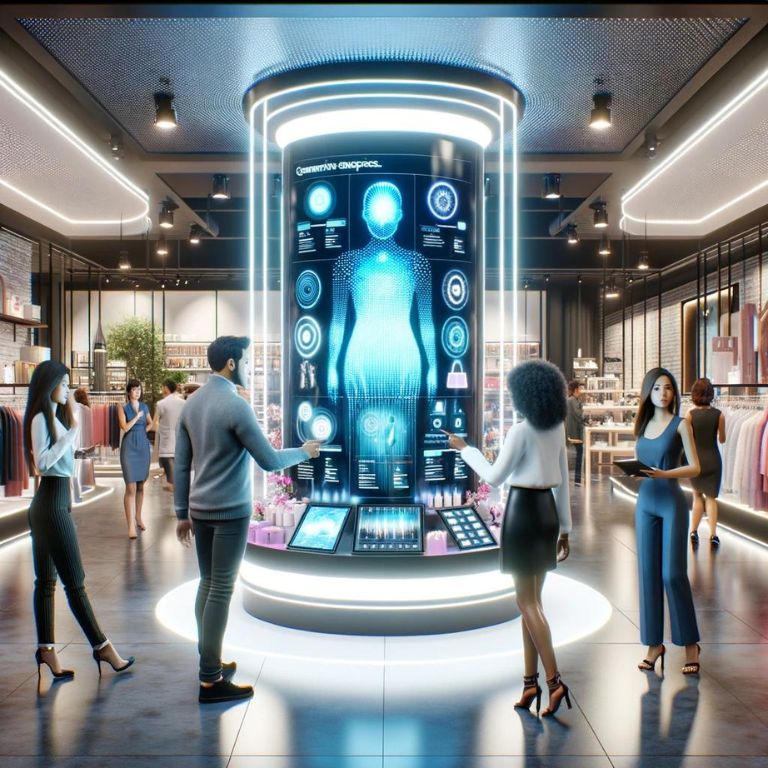In the dynamic world of retail, staying ahead means adopting the latest technologies. Generative AI, a groundbreaking innovation, is redefining how retailers interact with customers, offering unprecedented personalization and insights into consumer trends. This guide explores the transformative power of generative AI in retail, highlighting its potential to revolutionize the shopping experience.
Understanding Generative AI in Retail
What is Generative AI?
Generative AI refers to advanced algorithms that analyze vast amounts of data to generate predictions, recommendations, and insights. Unlike traditional AI, which responds to direct inputs, generative AI can anticipate needs, propose solutions, and create new content, making it a game-changer in retail.
How Generative AI Stands Out
The key lies in its ability to learn from data patterns, enabling it to generate highly accurate, personalized recommendations and trend forecasts. This ability sets it apart from conventional AI tools, offering a more nuanced understanding of consumer behavior.
Personalization in Retail through AI
In the contemporary retail landscape, personalization is not just a luxury; it’s a necessity for staying relevant and competitive. Generative AI is at the forefront of this revolution, transforming how retailers interact with customers by providing highly individualized experiences. This section delves into how AI personalizes the customer journey, showcases successful real-world applications, and examines the impact of this technology on customer loyalty and revenue.
Tailoring the Customer Journey
The power of generative AI in retail lies in its ability to process and learn from vast amounts of consumer data. This includes purchase history, browsing behavior, and even social media activity. By analyzing these data points, AI algorithms can predict customer preferences and behaviors with astonishing accuracy. This capability allows retailers to offer personalized product recommendations, customized marketing messages, and even tailor the in-store experience to individual customer needs.
For instance, a customer who frequently buys eco-friendly products might receive recommendations for similar items, or someone who regularly shops for children’s clothing could be targeted with promotions and new arrivals in that category. This level of personalization not only enhances the shopping experience but also makes the customer feel understood and valued.
Success Stories

Leading retailers are already harnessing the power of AI to provide personalized experiences. Amazon’s recommendation system is a prime example. It uses customer data to suggest products, leading to a significant increase in customer engagement and sales. Another example is Zara, which uses AI to analyze customer preferences and feedback to inform its design and stock decisions, ensuring that its stores always have what their customers are looking for.
These success stories highlight the tangible benefits of AI-driven personalization in retail. By leveraging AI, these companies have not only increased their sales but also strengthened their customer relationships.
Impact on Loyalty and Revenue
The implementation of AI in personalization strategies has a direct impact on customer loyalty and revenue growth. Personalized experiences make customers more likely to return, increasing customer retention rates. A study by Boston Consulting Group found that retailers that have implemented personalization strategies see sales gains of 6-10%, a rate two to three times faster than other retailers.
Moreover, personalization can lead to increased customer satisfaction. Customers are more likely to feel a connection with a brand that understands their needs and preferences, which in turn fosters brand loyalty. This loyalty translates into repeat purchases and higher lifetime value of customers.
Generative AI’s role in personalizing retail experiences is multifaceted and profoundly impactful. It not only enhances the shopping experience for customers but also drives revenue growth and customer loyalty for retailers. As AI technology continues to evolve, its capabilities in personalization will become even more sophisticated, further revolutionizing the retail industry.
Predicting Consumer Trends with AI
Generative AI is not just transforming the present of retail; it’s shaping its future. One of the most significant impacts of AI in the retail sector is its ability to predict consumer trends. This predictive power enables retailers to be proactive rather than reactive, staying ahead of market shifts and consumer preferences. This section explores how AI forecasts trends, its role in inventory management and marketing, and real-world examples of its successful application.
Forecasting with Precision
The ability to anticipate and adapt to consumer trends is crucial for retailers to stay relevant and competitive. Generative AI excels in this area by analyzing a wide array of data sources, including sales data, online browsing habits, social media trends, and even global economic indicators. Through complex algorithms, AI can identify patterns and predict which products are likely to become popular, which trends are fading, and what new consumer behaviors are emerging.
For instance, AI can analyze social media data to identify emerging fashion trends or use sales data to predict which products will be in high demand in different seasons. This level of forecasting goes beyond traditional market research methods, offering more nuanced and real-time insights.
AI in Inventory Management and Marketing
Effective trend prediction has a direct impact on inventory management and marketing strategies. With AI-driven insights, retailers can optimize their stock levels, reducing the risk of overstocking or understocking. This optimization not only cuts costs but also ensures that customers find what they are looking for, enhancing their shopping experience.
In marketing, AI’s predictive capabilities allow for more targeted campaigns. By understanding future trends, retailers can tailor their marketing efforts to align with anticipated customer interests, increasing the effectiveness of their advertising and promotional activities.
Real-world Examples
Many leading retail brands have leveraged AI to stay ahead of consumer trends. Nike, for instance, uses AI to analyze market trends and customer feedback, helping them design products that resonate with their target audience. H&M employs AI to analyze store returns, customer receipts, and data from loyalty cards to predict what garments will sell well.
These examples demonstrate how AI not only enhances the accuracy of trend predictions but also enables retailers to be more agile and responsive to market changes. The result is a more dynamic retail environment where consumer needs are met more effectively and efficiently.
The predictive power of generative AI represents a paradigm shift in how retail operates. By accurately forecasting consumer trends, AI enables retailers to make more informed decisions about inventory, marketing, and overall strategy. This foresight is not just a competitive advantage; it’s becoming a necessity in the rapidly evolving retail landscape.
c
The integration of generative AI into retail operations marks a critical step towards modernizing and optimizing the retail business. It’s a process that requires careful planning, execution, and adaptation. This section provides a step-by-step guide to effectively integrate generative AI into your retail operations, ensuring a smooth transition and maximum benefit from this technology.
Step 1: Identifying Objectives and Needs
- Assess Current Operations: Begin by evaluating your current retail processes and identifying areas where AI can add value. This could be customer service, inventory management, trend prediction, or personalization.
- Define Clear Objectives: Set specific, measurable goals for what you want to achieve with AI. This could include increasing sales, improving customer satisfaction, or reducing operational costs.
Step 2: Selecting the Right AI Tools and Technologies
- Research AI Solutions: Investigate different AI tools and technologies that align with your identified needs. Consider factors like ease of integration, scalability, and support.
- Choose the Appropriate Technology: Select AI solutions that match your business size, budget, and technical capabilities. This might involve choosing between off-the-shelf products or custom solutions.
Step 3: Partnering with AI Experts and Vendors
- Seek Expertise: If you lack in-house AI expertise, consider partnering with AI consultants or vendors who can offer guidance and support throughout the integration process.
- Collaborative Planning: Work closely with your chosen experts to develop a detailed implementation plan that aligns with your business objectives.
Step 4: Pilot Testing
- Start Small: Implement AI solutions on a small scale initially. Choose a single store or a specific aspect of your operations as a testbed.
- Monitor and Evaluate: Collect data on the performance of the AI system during the pilot phase. Pay attention to both the system’s effectiveness and its impact on your operations and customer experience.
Step 5: Training and Staff Onboarding
- Educate Your Team: Ensure your staff understands how to work with the new AI tools. Provide training sessions to familiarize them with the technology.
- Foster Adaptation: Encourage your team to adapt to the new systems and provide feedback. Employee involvement is crucial for successful AI integration.
Step 6: Full-scale Implementation
- Expand Gradually: Based on the success of the pilot, gradually roll out the AI solution across your entire operation.
- Continual Monitoring: Continuously monitor the performance and impact of the AI system. Be prepared to make adjustments as needed.
Step 7: Overcoming Challenges
- Address Technical Challenges: Work with your IT team and AI vendors to resolve any technical issues that arise during implementation.
- Manage Change: Address resistance to change among staff by highlighting the benefits of AI and providing ongoing support and training.
Step 8: Regular Review and Adaptation
- Assess Performance: Regularly review the performance of the AI system against your initial objectives.
- Stay Agile: Be prepared to adapt and update your AI solutions as technology evolves and your business needs change.
Integrating generative AI into retail operations is a journey that involves strategic planning, careful selection of technology, and a willingness to adapt and evolve. By following these steps, retailers can harness the power of AI to enhance efficiency, improve customer experiences, and stay competitive in an ever-changing market. Remember, the key to successful AI integration is not just in the technology itself, but in how it’s implemented and embraced within the organization.
Ethical Considerations and Consumer Privacy
As retailers increasingly turn to generative AI to enhance customer experiences and operational efficiency, it’s crucial to address the ethical implications and privacy concerns associated with this technology. This section discusses the importance of ethical AI practices and the protection of consumer privacy, offering guidelines to ensure responsible use of AI in retail.
Navigating the Ethical Landscape of AI in Retail

- Understanding the Ethical Implications: The use of AI in retail raises several ethical questions, particularly regarding data usage, bias in AI algorithms, and transparency. Retailers must recognize these implications and commit to ethical AI practices.
- Preventing Bias in AI Systems: AI algorithms can inadvertently perpetuate biases if they’re trained on skewed or unrepresentative data. Retailers should strive to use diverse data sets and regularly audit their AI systems for any signs of bias.
- Maintaining Transparency with Customers: Transparency is key in building trust. Retailers should be open about their use of AI, including what data is collected and how it’s used. This transparency extends to explaining how AI influences product recommendations and pricing.
Protecting Consumer Privacy in the Age of AI
- Prioritizing Data Security: With the increasing reliance on consumer data for AI-driven personalization, safeguarding this data against breaches is paramount. Retailers must invest in robust cybersecurity measures and regularly update them to protect consumer data.
- Complying with Privacy Regulations: Adherence to data protection laws like the GDPR in the European Union and various state laws in the U.S. is not just a legal requirement but also a trust-building measure with customers. These regulations mandate explicit consent for data collection and offer consumers control over their data.
- Ethical Data Collection and Usage: Retailers should collect only the data necessary for their AI systems to function effectively and use this data solely for the purposes communicated to customers. This practice involves obtaining explicit consent from customers before collecting their data and being transparent about its use.
Building a Framework for Ethical AI
- Developing Ethical Guidelines: Retailers should establish a set of ethical guidelines for AI deployment. This includes principles on data usage, privacy, and transparency.
- Regular Ethics Audits: Conduct regular audits to ensure compliance with these guidelines and to assess the ethical impact of AI systems.
- Incorporating Stakeholder Feedback: Engage with customers, employees, and other stakeholders to gather feedback on AI practices and address any concerns they may have.
The integration of generative AI into retail brings immense possibilities for innovation and efficiency. However, it also requires a commitment to ethical practices and consumer privacy. By navigating these considerations carefully, retailers can harness the benefits of AI while maintaining customer trust and adhering to ethical standards. As AI technology continues to evolve, so too should the strategies for its ethical and responsible use in retail.
The Future of Retail with AI
The retail landscape is continuously evolving, and generative AI is playing a pivotal role in shaping its future. As AI technologies become more sophisticated and integrated into various aspects of retail, they promise to further revolutionize the industry. This section explores emerging trends, future technologies to watch out for, and the evolving role of AI in creating futuristic consumer experiences.
Emerging Trends in AI and Retail
- Enhanced Personalization: Future AI systems will offer even more advanced personalization, predicting customer needs and preferences with greater accuracy. This could include AI-driven personalized shopping assistants and more intuitive recommendation engines.
- Seamless Omnichannel Experiences: AI will bridge the gap between online and offline retail, providing a seamless omnichannel shopping experience. Customers will receive consistent, personalized service whether they shop online, in-store, or through social media platforms.
- Sustainable and Ethical Retail Practices: AI will play a crucial role in promoting sustainability in retail, from optimizing supply chains for minimal environmental impact to helping consumers make more eco-friendly purchasing decisions.
Technologies to Watch
- Advanced Machine Learning and Neural Networks: As machine learning algorithms and neural networks become more advanced, they will offer deeper insights and more accurate predictions, further enhancing customer experiences and operational efficiency.
- Augmented Reality (AR) and Virtual Reality (VR): These technologies, combined with AI, will transform the shopping experience, offering virtual try-ons, immersive product demonstrations, and interactive shopping environments.
- Internet of Things (IoT) Integration: AI will increasingly interact with IoT devices, enabling smarter inventory management, enhanced customer service, and innovative in-store experiences.
Evolving Consumer Experiences
- Hyper-Personalized Shopping Journeys: AI will facilitate highly individualized shopping journeys. From AI-curated fashion selections to personalized health and nutrition recommendations, AI will cater to the unique needs and preferences of each customer.
- AI-Powered Customer Service: Advances in natural language processing will enable AI to provide more nuanced and effective customer service, both online and in physical stores.
- Interactive and Immersive Shopping: Retail spaces will become more interactive and immersive, with AI and AR/VR technologies offering customers new ways to engage with products and brands.
The future of retail with AI is one of endless possibilities. As AI continues to advance, it will not only transform how retailers operate but also redefine the shopping experience for consumers. Retailers who embrace these AI-driven changes will be well-positioned to thrive in this new era of retail, characterized by personalization, efficiency, and innovation. The journey towards this future is as exciting as it is challenging, and it will require continuous adaptation, learning, and a commitment to leveraging technology for the betterment of the industry and its customers.
Embracing the Future of Retail with AI Integration
As we reach the conclusion of our exploration into integrating generative AI into retail operations, it becomes increasingly clear that this technological advancement is not just a fleeting trend, but a cornerstone of future retail strategies. The implementation of AI in retail signifies a pivotal shift towards more efficient, customer-centric, and data-driven operations. By adopting AI, retailers are not only optimizing their current processes but are also positioning themselves to proactively adapt to future market changes and consumer demands. This strategic move fosters enhanced customer experiences, streamlined operations, and ultimately, sustained business growth.
In summary, the journey of integrating generative AI into retail is one of transformation and innovation. While challenges are inevitable, the benefits – from personalized customer experiences to predictive trend analysis and operational efficiency – are profound and far-reaching. As retail continues to evolve in this digital era, embracing AI is no longer an option but a necessity for those who aspire to lead and excel in the competitive retail landscape. Retailers who recognize and leverage the power of AI will not only survive but thrive in the dynamic world of retail.




